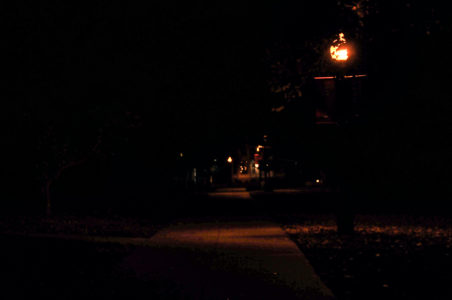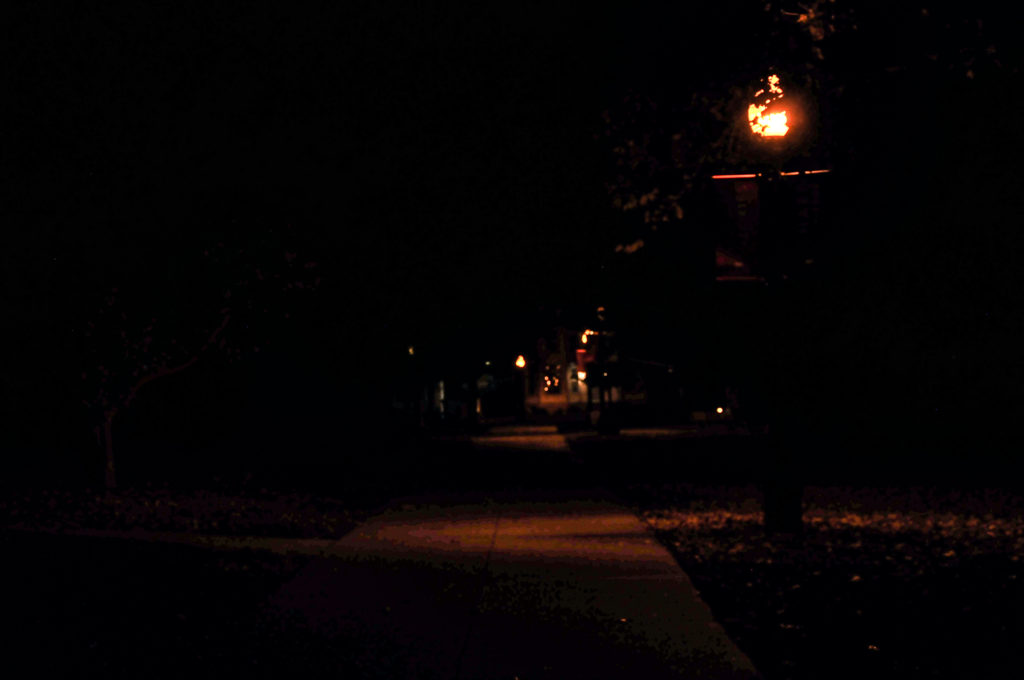fruchter@grinnell.edu
A picture of paths on campus, or of the streets bordering the College at night, is unlikely to pick up much detail besides the faint glow of a light in the distance. For those who walk off-campus frequently, this pitch-black scene has come to be familiar.
“I usually walk home after dark and there are no streetlights and very few people around,” said one respondent to a Sept. 30, 2018 survey administered by The S&B on the experiences of students walking home at night. The respondent indicated that they “often” felt unsafe walking at night.
Per the survey, administered over Facebook, approximately 50 of the 150 respondents indicated a relationship between the lack of adequate lighting and feeling unsafe walking home.
On a scale ranging from “never” to “always” feeling unsafe walking at night, other respondents who indicated that they “often” or “always” felt unsafe explicitly stated lack of lighting on High Street and Park Street as a factor contributing to this feeling of unease. Both streets, along with Broad Street and East Street, are heavily populated by students living within two blocks of campus.
In an email to The S&B, Russ Behrens, Grinnell City Manager, added an infrastructural perspective to the question of streetlights in Grinnell. “Adding or improving street lights can be a relatively easy step,” wrote Behrens.
Behrens suggests that those wishing to improve lighting on a specific street write a letter to the mayor, who currently is Dan Agnew, explaining their reasoning and propose a solution to the problem. From there, the city council will decide whether to implement the solution.
While improving lighting off-campus involves appealing to the city government, Student Government Association (SGA) President Myles Becker ’19 and Vice President for Student Affairs Kadiata Tombou ’19 have been working with other SGA cabinet members to lobby the College administration to improve lighting on-campus.
Becker said that improving lighting on campus is a SGA priority this year. He pointed to the multiple student initiatives surrounding this topic, as well as recent stories from students of harassment at night, as evidence of the urgency and relevancy of better lighting on campus.
Following a student’s account of harassment at night on social media, Becker brought the issue of lighting to the Office of Student Affairs, who discussed the issue with Rick Whitney, Assistant Vice President of Facilities Management.
“The weird thing about this issue is that it really only impacts the community at night, which you know is typically after administration has left so its something they don’t see unless it’s brought to them,” said Becker.
Following Fall Break, Becker, Tombou and other members of SGA met with Whitney about reconnecting lights disturbed by the construction of the Humanities and Social Studies Complex (HSSC) and new admissions building. Whitney is currently working with contractors to reconnect the lines which were cut to lights in these areas, as well as retrofitting existing lamp posts across campus with LED bulbs.
Becker hopes that student voices will help bolster SGA’s work on lighting, signaling to administration that the issue is one which students care about. This year, a student initiative proposed there be more lights on campus, especially on Broad St. and in front of the Alumni Recitation Hall (ARH). The background for the proposal stated “Apart from areas around Burling, JRC and Noyce, the campus is too dark at night,” and “well-lighted streets” was listed as the desired outcome of the initiative. Becker predicts the initiative will pass but says that even if it doesn’t, SGA will still work on the issue.
Concerns precede this SGA initiative, as evidenced by a 2017 survey administered by Kara Nielsen ’17, Zach Steckel ’18, Carson Peters ’20, and Madison Wardlaw ’20, conducted “to gauge students’ feelings about lighting and safety on campus.” They received 230 distinct respondents, analyzed the data and made recommendations based on their analysis. The students found that 83 percent of survey participants identified at least one area of campus as having inadequate lighting, on the grounds of either safety or convenience. The group submitted their report to former head of Student Affairs, Andrea Conner.
The report recommended that 11 pathways on campus required increased lighting. The students also reported that the most common technical issue students identified were lights that turned off when approached. Though the report was filed in 2017, Becker confirmed that such lights are still an issue today.
Nielsen, Steckel, Peters and Wardlaw found that, even though the survey did not mention the blue light system, seven percent of survey participants called for more blue lights and emergency lights.
Becker expressed confidence in both the student body and government’s ability to take action to increase lighting on campus, making the connection between change and student involvement explicit to affecting this issue.
The College technically has a blue light system installed on campus to assure student safety. A blue light system consists of a network of emergency phones, which automatically call campus safety when picked up, and which are identified by a bright blue light. In theory, if a student were being pursued, they could quickly pick up and then drop the receiver on multiple blue light phones as a signal to security and a record of their path across campus. Grinnell College, however, only has three visible blue lights: one between the Joe Rosenfield Center (JRC) and Younker Hall, one next to the tennis courts and a third on the west side of the Forum, calling into question the efficacy of the system.
“I think that one of the big flaws with blue lights on campus currently is that we have many of them that students don’t know about,” said Riley Murphy ’19, SGA Vice President of Academic Affairs. “The little phones inside of the loggias, they all have the same function as blue lights.”
Murphy, who first inquired into the blue light system during his second year at College as a campus senator, stated that the blue light system is seen largely as a hassle by administration and campus safety who worry that the implementation of more lights may cause an increase in unnecessary use of the lights as a prank. Murphy proposes, however, that blue lights be placed atop phones around campus such as those in the loggia so that they are more readily accessible.
Additionally, the Division of Student Affairs is working with the Harm Reduction Committee, SGA and Information Technology Services (ITS) to look into a potential app that would work like a blue light, allowing students to share their location with campus safety and the Grinnell Police Department. Murphy stated that the timeline for this app is still in flux as these organizations seek the proper platform.
“It’s really nice when we’re able to work in collaboration with [the Division of Student Affairs] and have something that a student concern is made into action items. That’s one of those situations here, where with campus blue lights, its something we’ve been talking about for a long time and we’re finally starting to make tangible plans … creating a better system, that’s what we’re going for,” said Murphy.
The S&B’s investigation into student safety at night will focus on institutional forces and responsibilities. The investigation will evaluate the role of both Grinnell College and the town of Grinnell. Future pieces will include but are not limited to discussing the role of zoning laws in lighting distribution, the office of campus security and avenues of recourse available for students who have experienced harassment or assault off-campus.
This series is open and evolving. Please contact [fruchter] or [wraychlo] if you would like to share your story or give your input to this investigation.

Photo by Liz Paik


































































